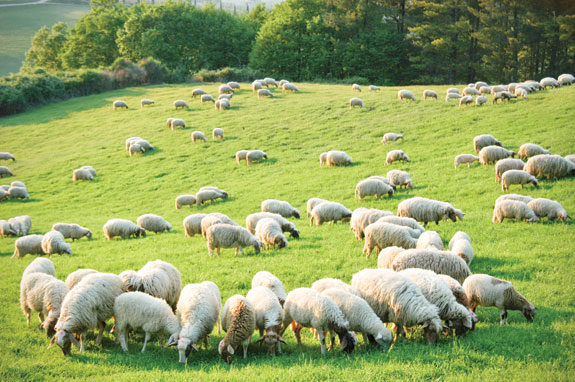Fencing is a key factor in controlling sheep and is necessary for animal control, predator reduction and makes a managed grazing system work. Adequate fencing should be employed early in the planning process.
Problem weed control should also be executed as an early goal to reduce competition with grazing plants and before adding legumes or forbs to the pasture mix. Control could be mechanical, chemical or a combination, depending upon the type of weed or brush.
Don’t let soil fertility limit your pasture productivity. Test to determine the pH, P and K available for plant growth. A pH of 6.5 to 7.0 is essential when establishing legumes.
Frost seeding small-seeded grasses like orchardgrass or legumes (red clover or white clover) can be accomplished by broadcasting seed mid-February in Illinois. Freezing and thawing of the soil surface is critical to provide seed/soil contact and success. Legumes are deeper rooted than grass and have more summer productivity. They provide nitrogen to the companion grasses, thus adding quality and crude protein to the forage.

Sheep producers should use as much forage as practical to meet the nutritional needs of the sheep. This will help to reduce the costs for purchased and stored feeds. Grazers should try to optimize pasture yield, quality and persistence of the forage. This can be done with the development of a managed grazing program. This allows the grass producer to work smarter – not harder – and limit forage waste.
Managed grazing
Managed grazing allows shepherds to use a higher stocking density that requires fewer acres. This would permit either additional sheep numbers or increased grazing days for the operation. A series of smaller paddocks are used to rotate animals, which allows for a forage rest period. Rest periods of 30 days are necessary to maintain legumes in the stand.
Sheep are moved more frequently among the paddocks based upon forage quality, quantity and their nutritional needs. The grazing period in each paddock should be short (six days or less). This reduces spot grazing and re-grazing palatable plants.
Paddock grazing cycles for dairy sheep of one-half to one day provide very high-quality forage. Finishing lambs on forage requires one- to three-day cycles. Rams and ewes would have a four- to six-day cycle depending upon nutritional needs. Weaned lambs might be given access the first few days in a grazing cycle, followed by mature sheep to clean up the lower-quality forage.
Good quality pasture increases the grazing or harvest efficiency of forage. Continuous grazing may only capture 25 to 30 percent of the available forage. Managed grazing may more than double the forage utilized by the sheep.
Animals should be moved to the next paddock when 3 to 4 inches of forage stubble remain for photosynthesis (plant growth) and to prevent overgrazing. Managed grazing means closer contact with the sheep and better flock management. Managed grazing can be a sustainable, size-neutral technology that can be used if you have five ewes or 500 in the flock.
Other considerations
Identify water availability in each paddock. Research suggests the need for water within 800 feet of grazing animals for best pasture utilization and waste recycling. Water should be available at 2.5 gallons of water per ewe and lamb per day.
Evaluate existing forages and browse areas and interseed thin spots rather than destroying root mass.
Identify paddocks that could be used for hay by looking for equipment access ease. Consider harvesting 20 percent of the paddocks for first- cutting hay and feed during winter shortages or rainy periods on newer pastures. This will keep forages more vegetative (higher quality). Paddocks can be brought into the grazing rotation later in the season when there is a natural slump of forage production (hotter, dryer weather).
Drawbacks of managed grazing
Initial investments in fencing and water systems may limit adoption by some producers. Soil compaction concerns can be reduced by having an all-weather paddock or sacrifice paddock to move sheep during wet, thawing or muddy periods.
Increased grazing management requires improved management skills of the operator. There is a perception of an increased labor demand. After the system is set up, labor demand may actually be reduced.
Extending the grazing season
Each day sheep graze and harvest forages, they require less purchased feed and hay. Sheep producers should use crop residues, annual forages, brassica crops (turnips, rape and kale) and stockpiled cool-season forages to maximize grazing days.
Corn crop residues can provide grain and forage for sheep. Vaccinate ewes or lambs for overeating disease two weeks before turnout. Strip or rotational grazing can reduce the amount of corn offered and improve residue quality. Grazing cornfields can help to reduce volunteer corn in following soybean crops. Protein and mineral supplementation may be required.
Annual cereal crops like oats, wheat or rye can be seeded to supplement spring, summer or fall grazing. They can be aerial-seeded into standing corn in mid-August, which can greatly improve grazing quality of corn residue.
Oats may be more cost-effective because it has more fall growth and will winterkill in December. Sorghum sudangrass and hybrids are warm-season, annual crops that can provide grazing during the summer slump of cool-season grasses or when stockpiling forages.
Early grazing (less than 24 inches tall or following frost) may lead to prussic acid poisoning. Pearl millet, a leafier warm-season grass, can be grazed earlier than the sorghums and has no prussic acid potential; however, it yields less.
Brassica crops like turnip, rape, kale and hybrids can be used to extend the grazing season. Planting can occur early in the spring (April) or July following wheat or oat harvest, depending upon forage needs. Brassicas are very high quality and be similar to feeding grain. They should be planted with a fiber source like oats or fed with hay to reduce digestive problems. Strip-graze brassicas to reduce waste.
Stockpiled cool-season forages
Start stockpiling cool-season forages 70 to 75 days before a killing frost with 3 to 4 inches of growth. Apply 50 pounds of nitrogen per acre. This should provide about one ton of forage dry matter per acre. Stockpile should be strip-grazed to reduce trampling and waste. Tall fescue is an excellent species for stockpiling. Stockpile can be grazed ‘til spring if you have enough acreage. Sheep will graze through 6 inches of snow but can be limited by ice. Happy grazing in 2010! FG











